Salem
Salem, the county town of Essex County, was founded in 1626 but is best known for events in 1692. The settlement was founded by a group of fishermen from Cape Ann led by Roger Conant who named it Naumkeag. More settlers arrived from the Massachusetts Bay Colony in 1628. They took over control of the settlement and changed the name to Salem, a derivation of the Hebrew word for peace. Salem originally covered a much larger area, including the nearby towns of Marblehead and Danvers. It was in Danvers, then known as Salem Village, that the events for which Salem is famous started. The daughter and niece of the Reverend Samuel Parris began to have violent ‘fits’. A third girl was also affected and a local physician diagnosed them all as bewitched. Questioned by local magistrates, the girls blamed three local women for their ‘fits’. The three women were put on trial, two claimed innocence but the third confessed that ‘the Devil came to me and bid me serve him.’. She also said that said there were other witches aiming to destroy the Puritan settlers. This triggered panic in the local community. The three women were put in jail and dozens of people from Salem and the surrounding area were brought in for questioning and many put on trial. By the time the panic subsided, 19 people had been hanged and one crushed to death. All this leaves little room to cover more of Salem’s history; it grew into a major seaport, but tourism is now a major industry built upon a wealth of history buildings and the story of the witch trials.
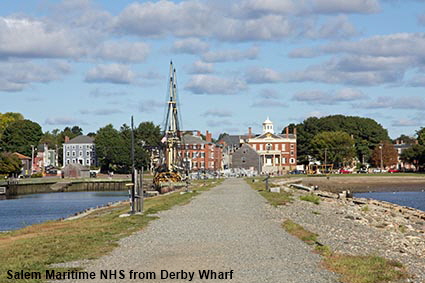
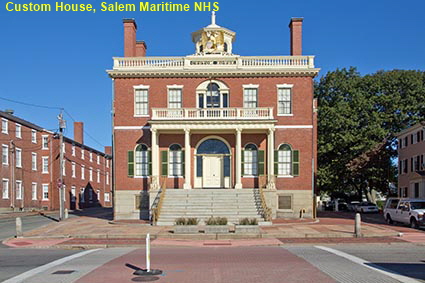
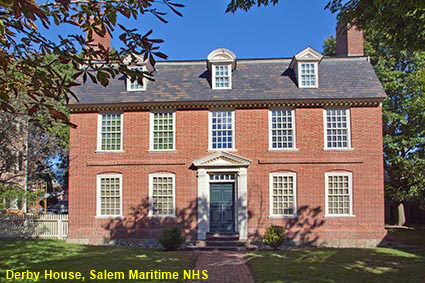
Click on Minimap to navigate
Derby House, Salem Maritime NHS
This house was built in 1762 by Captain Richard Derby as a wedding gift for his son Elias Hasket and his new wife Elizabeth. They lived in the house for more than 20 years. During the Revolutionary War, Hasket Derby converted many of his ships to privateers. After the war the considerable wealth that he amassed from privateering enabled him to start trading with the East Indies and China. In 1796, the Derbys sold the house to to Capt. Henry Prince who built the West India Goods Store next to the house, another of the buildings that form the National Historic Site. The Derby House is normally open to the public, but at the time of writing it was closed for preservation work. Click tab 2 to see the garden.
Custom House, Salem Maritime NHS
The first Custom House was built in 1649 to collect on taxes on cargoes imported through Salem. The building that you see here was the 13th Custom House, built in 1819. The building housed offices for Federal Customs Officials while an attached warehouse, the Public Stores, was used to store bonded and impounded cargo from around the world. The Custom House is open to the public daily in season and for tours on weekends only out of season.
Salem Maritime NHS from Derby Wharf
Since it was founded by fishermen, it should be no surprise that Salem had an excellent harbour. During the Revolutionary War, Salem became a base for privateers but when the war ended this lucrative business died away. The ships used by the privateers were too large for transporting goods along the coast of the early USA, so Salem became a centre for trade with far-flung places. Ships would arrive with sugar and molasses from the West Indies or spices from the Far East. The Napoleonic Wars between Britain and France resulted in both countries putting embargoes on US trade, which hit Salem but the British Embargo led to the War of 1812 which gave an opportunity for some Salem vessels to return to privateering. As the 19th century wore on, Salem’s harbour began to silt up and shipping trade declined. Manufacturing helped to offset the decline, particularly tanning, shoe making and manufacture of cotton goods. Most of these closed down during the 20th century leaving Salem as commuter and tourist town. Many historic buildings still stand including several that reflect Salem’s maritime history. These buildings plus the Derby Wharf and a replica of a 1797 East Indiaman called ‘Friendship of Salem’ (visible in picture) have been brought together to form the Salem Maritime National Historic Site.
Home > US States > New England > Massachusetts > Essex County >
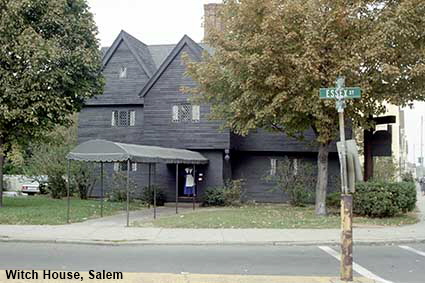
Witch House
This is the only house still standing in Salem that has a direct link with the infamous 1692 Witchcraft Trials. Nineteen men and women were hanged for witchcraft and an octogenarian man was crushed to death under stones for refusing to submit to a trial. This was not the home of one of the alleged witches but was the residence of magistrate Jonathan Corwin. The date that the house was built is unknown. There are claims that may date back as far as the 1620s but others believe that it was still under construction when Corwin purchased it in 1675. He lived in the house for more than forty years. As local magistrate, it was Corwin who had the task of investigating the claims of witchcraft including interrogating some of the suspects. However, he did not interrogate suspects in his home. In 1944 the house was threatened by a road widening scheme. Local people raised $42,500 to move the building 11 metres (35 feet) and restore it to how it would have looked at the time of the witch trials. The Witch House is open for tours daily in season and Thursday to Sunday at other times.
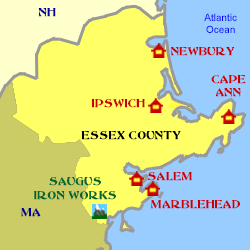
DLU171211


To move forwards or backwards through the Essex County trail click the arrows above, or select your next destination on the Minimap.

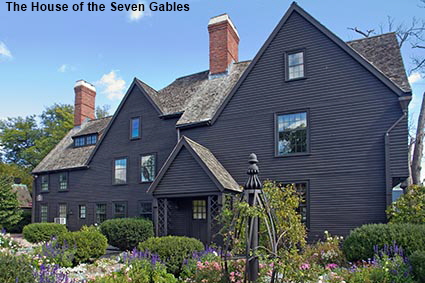
The House of the Seven Gables
This is an historic house with literary connections. The centre section of the house was built in 1667 by Captain John Turner. It was originally had two rooms on the ground floor with two rooms over them and a central chimney. As Turner’s wealth grew, he twice extended the house. John Turner died in 1680 and his son John Turner II inherited the house. In the early 18th century, he remodelled it in the Georgian style. All the extensions and remodelling over the years resulted in a house with seven gables. John Turner III inherited the house but he lost the family fortune and in 1782 it was sold to Captain Samuel Ingersoll who removed four gables and remodelled it in the Federal style. After Ingersoll died in 1804, his daughter Susanna Ingersoll inherited the property. She was the second cousin of author Nathaniel Hawthorne and in the 1840s he was a frequent visitor. Susanna told Nathaniel about the history of the house back to the time when it had seven gables, and it provided an inspiration for his 1851 romantic novel ‘The House of the Seven Gables’. In 1908 Turner-Ingersoll mansion was purchased by Caroline Emmerton, founder of the House of Seven Gables Settlement Association. She restored the house back to seven gables, and made other changes, some more in line with the novel than historical fact. She renamed the mansion ‘The House of the Seven Gables’ and opened it for public tours. The house where Nathanile Hawthorne was born in 1804 originally stood at 27 Union Street but in 1958 it was moved to the grounds of the House of the Seven Gables and now forms part of the museum. Click tab 2 to see Nathaniel Hawthorne's Birthplace (c1750).
Salem Witch Museum
If you want to find out more about the 1692 Witchcraft Trials then you might want to go to the Salem Witch Museum. It is worth pointing out that this is not a true museum, it is not a collection of artefacts associated with the trials. Instead it is a display comprising a series of life sized wax figures in scenes from the events of 1692 and the story is told by a guide.
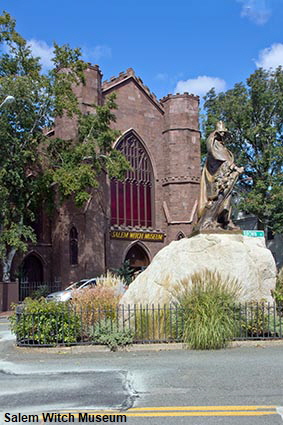
John Ward House, Brown Street
The John Ward House was built in 1684 at 38 St. Peter Street in Salem, opposite the jail used during the witchcraft trials. The original building comprised a single ground floor room with a single room over it and a chimney at one end. He later added the end nearest the camera in the picture, turning it into a five bay house with centre chimney. the John Ward died in 1732 and around that time a leanto was added at the rear creating the asymmetrical roof of a saltbox house.. It underwent several subsequent changes until in 1910 it was bought by the Essex Institute. They moved the house to its current location in Brown Street and restored it broadly to its 1700 state but leaving the 1732 extension in place. The John Ward House is one of several historic buildings now forming part of the Peabody Essex Museum. The house is open to visitors Tuesday to Sunday.
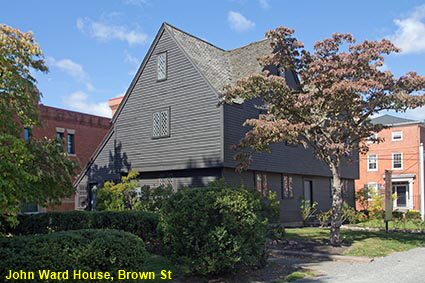
© Mike Elsden 1981 - 2025
The contents of this page may not be reproduced in full or in part without permission